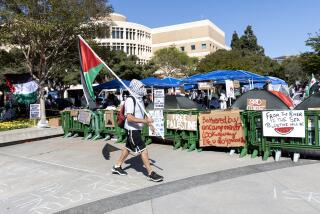At sit-in, students urge USC to ensure apparel is not sweatshop-produced
Students staged a sit-in Tuesday outside the office of USC’s president, hoping the university would take measures to ensure that USC-themed apparel isn’t manufactured in sweatshops.
Thirteen students, who came prepared with food to last three days and pillows, ended their protest after about six hours when the university threatened to suspend them and, in a move that even surprised former 1960s student activist Tom Hayden, called their parents.
“We were prepared for arrest, but not suspension,” said Ana Valderrama, a senior in philosophy.
Hours earlier, as the students sat on the floor outside President Steven B. Sample’s office in Bovard Hall, about 35 other students rallied outside the building, joined by Hayden, a former lawmaker. The protesters waved signs, banged drums and chanted slogans such as “President Sample, prove your creed, don’t give in to corporate greed.”
Sample did not meet with the students. University spokesman James Grant said that the president attended meetings throughout the day and that he did not know whether Sample was in his office. “It’s very possible he left through another entrance,” Grant said.
The sit-in began about 11 a.m. and ended after the students were handed personally addressed letters that said, “I want to inform you that you have been placed on interim suspension from USC. “ The letters outlined eight charges of misconduct.
The three-page letters, signed by Denzil J. Suite, assistant vice president for student affairs, said that “effective 5 p.m. on April 10, 2007, you may not return to the University of Southern California.” It also added that “if you reside in university-owned housing, you must vacate your residence by 9 a.m. on April 11.”
The students were given 10 minutes to decide whether to end their sit-in -- and thus have the whole matter dropped. “We all got scared. You could feel the fear in the room,” said Meher Talib, a junior in international relations and one of the protesters.
The students asked for, and received, an additional five minutes to huddle before giving up.
To the cheers of about 150 students gathered outside the building, the protesters, some in tears, peacefully walked out. Talib said they were tears of frustration. “I’m upset that we didn’t win the campaign,” said Talib. “But that doesn’t mean the campaign is over.”
The campaign has been going on at USC for about eight years. The protesters were members of the Student Coalition Against Labor Exploitation, and they are part of a nationwide effort by students lobbying universities to make sure college-themed clothing is not produced under sweatshop conditions.
The students want USC to join the Worker Rights Consortium, an independent monitoring group, to ensure proper working conditions for those producing university-themed apparel. They also urged USC to join other colleges that abide by the consortium’s Designated Suppliers Program, which ensures that workers producing such apparel can form unions.
“We agree with their objective,” said Grant of the students. But he described the consortium as being on “the radical end” of the spectrum and said it does not equally represent manufacturers, as well as workers, in the garment industry. A university handout said USC belongs to the Fair Labor Assn., described as a trade group dedicated to improving workplace conditions in the clothing industry.
In the end, 12 students and one attorney from the National Lawyers Guild abandoned the sit-in. A 13th student and a second lawyer had left the protest for bathroom breaks and had not been allowed to return.
About 30 minutes before Michael L. Jackson, vice president of student affairs, delivered Suite’s letters, the university let loose another weapon: It began calling parents.
Worried parents then began calling the students on cellphones to urge them to quit the protest.
Said Andrew Bunting, an international relations and German major, of the parental calls: “It was clearly a very calculated ... one-two punch.”
*
More to Read
Sign up for Essential California
The most important California stories and recommendations in your inbox every morning.
You may occasionally receive promotional content from the Los Angeles Times.










